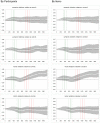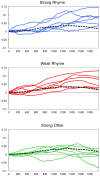Listening to Limericks: a pupillometry investigation of perceivers' expectancy
- PMID: 24086417
- PMCID: PMC3781151
- DOI: 10.1371/journal.pone.0074986
Listening to Limericks: a pupillometry investigation of perceivers' expectancy
Abstract
What features of a poem make it captivating, and which cognitive mechanisms are sensitive to these features? We addressed these questions experimentally by measuring pupillary responses of 40 participants who listened to a series of Limericks. The Limericks ended with either a semantic, syntactic, rhyme or metric violation. Compared to a control condition without violations, only the rhyme violation condition induced a reliable pupillary response. An anomaly-rating study on the same stimuli showed that all violations were reliably detectable relative to the control condition, but the anomaly induced by rhyme violations was perceived as most severe. Together, our data suggest that rhyme violations in Limericks may induce an emotional response beyond mere anomaly detection.
Conflict of interest statement
Figures



Comment in
-
Pupillometry: the eyes shed fresh light on the mind.Curr Biol. 2014 Mar 31;24(7):R281-2. doi: 10.1016/j.cub.2014.02.028. Curr Biol. 2014. PMID: 24698378
References
-
- Short M (1996) Exploring the language of poems, plays and prose. London: Longman.
-
- Hanauer D (2001) What we know about reading poetry. Theoretical positions and empirical research. In: Schram D, Steen G, editors. The psychology and sociology of literature. Amsterdam/Philadelphia: John Benjamins. 107–128.
-
- Carminati MN, Stabler J, Roberts AM, Fischer MH (2006) Readers' responses to sub-genre and rhyme scheme in poetry. Poetics 34: 204–218.
-
- Byron GG (1980–92). In: McGann JJ, Weller B, editors. Lord Byron: The complete poetical works. Oxford: Clarendon Press. 7 Volumes.
-
- Gray T (1965) In: Lonsdale R, editor. The poems of Gray, Collins and Goldsmith. London: Longman.
Publication types
MeSH terms
LinkOut - more resources
Full Text Sources
Other Literature Sources

